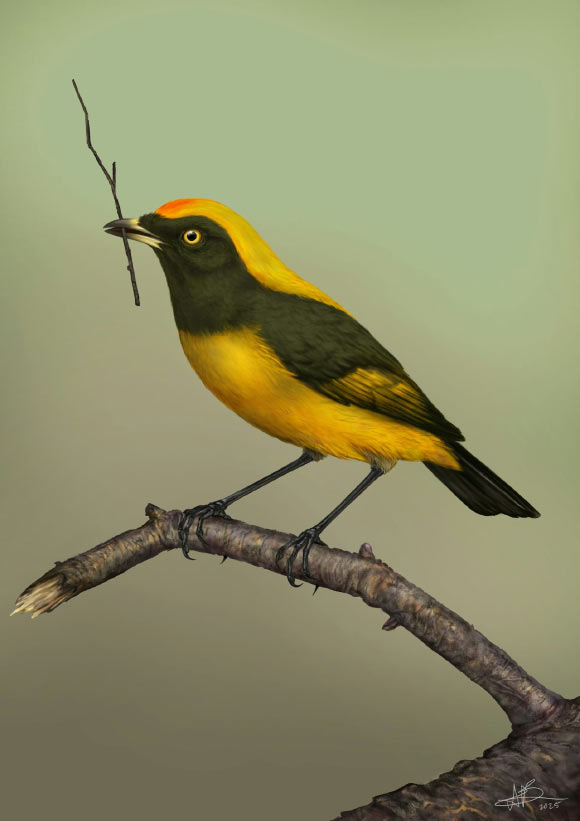Paleontologists have found the 2.9-cm-long fossilized foot bone of a possible bowerbird species at the Miocene locality of St Bathans in Aotearoa New Zealand.

Life reconstruction of the St Bathans bowerbird (Aeviperditus gracilis). Image credit: Sasha Votyakova / Te Papa / CC BY 4.0.
The newly-identified species inhabited New Zealand — far from its likely close relatives in Australia and New Guinea — during the Miocene epoch, between 19 and 14 million years ago.
“This discovery provides a wonderful and unique insight into the biological history of Aotearoa birds,” said Dr. Nic Rawlence, Director of the Otago Palaeogenetics Laboratory.
“To many people in the world, bowerbirds were made famous by Sir David Attenborough’s nature documentaries and their elaborate courtship behaviors, where males construct an arched structure called a bower, decorated with sticks and sometimes brightly colored objects like fruit, leaves or even pieces of plastic, all in an effort to attract a mate.”
Named Aeviperditus gracilis, or the St Bathans bowerbird, the new bird was much smaller than living bowerbird species.
“It is smaller than living and extinct bowerbirds, weighing in at 33 g, compared to 96-265 g for other species,” Dr. Rawlence said.
“Its foot bone is most similar to avenue bower builders that include the brightly-colored flame bowerbird and the satin bowerbird.”
“If this bird is indeed a relative of the bowerbirds, it could represent an entirely new songbird family for Aotearoa,” said Dr. Elizabeth Steell, a researcher at the University of Cambridge.
“That’s especially significant given the limited understanding we have of the ancient songbird fossil record in this region.”
“The St Bathans bowerbird is the latest songbird lineage to have a long evolutionary history in Aotearoa, where the oldest members of many different groups occur here including huia, kōkako, tīeke, piopio and mohua.”
“It’s likely that all these species represent the descendants of a rapid burst of evolution and dispersal from Australia to New Zealand.”
“Like some of the unique animals from St Bathans, there are no living descendants left in Aotearoa.”
“The bowerbird would have been particularly susceptible to cooling temperatures in the lead-up to the Ice Ages and the associated changes in forest make up and distribution, which likely contributed to its extinction,” Dr. Rawlence said.
A paper about the discovery of Aeviperditus gracilis was published October 7, 2025 in the Historical Biology, an International Journal of Paleobiology.
_____
Elizabeth M. Steell et al. A possible early bowerbird from the Miocene of New Zealand. Historical Biology, published online October 7, 2025; doi: 10.1080/08912963.2025.2568099







